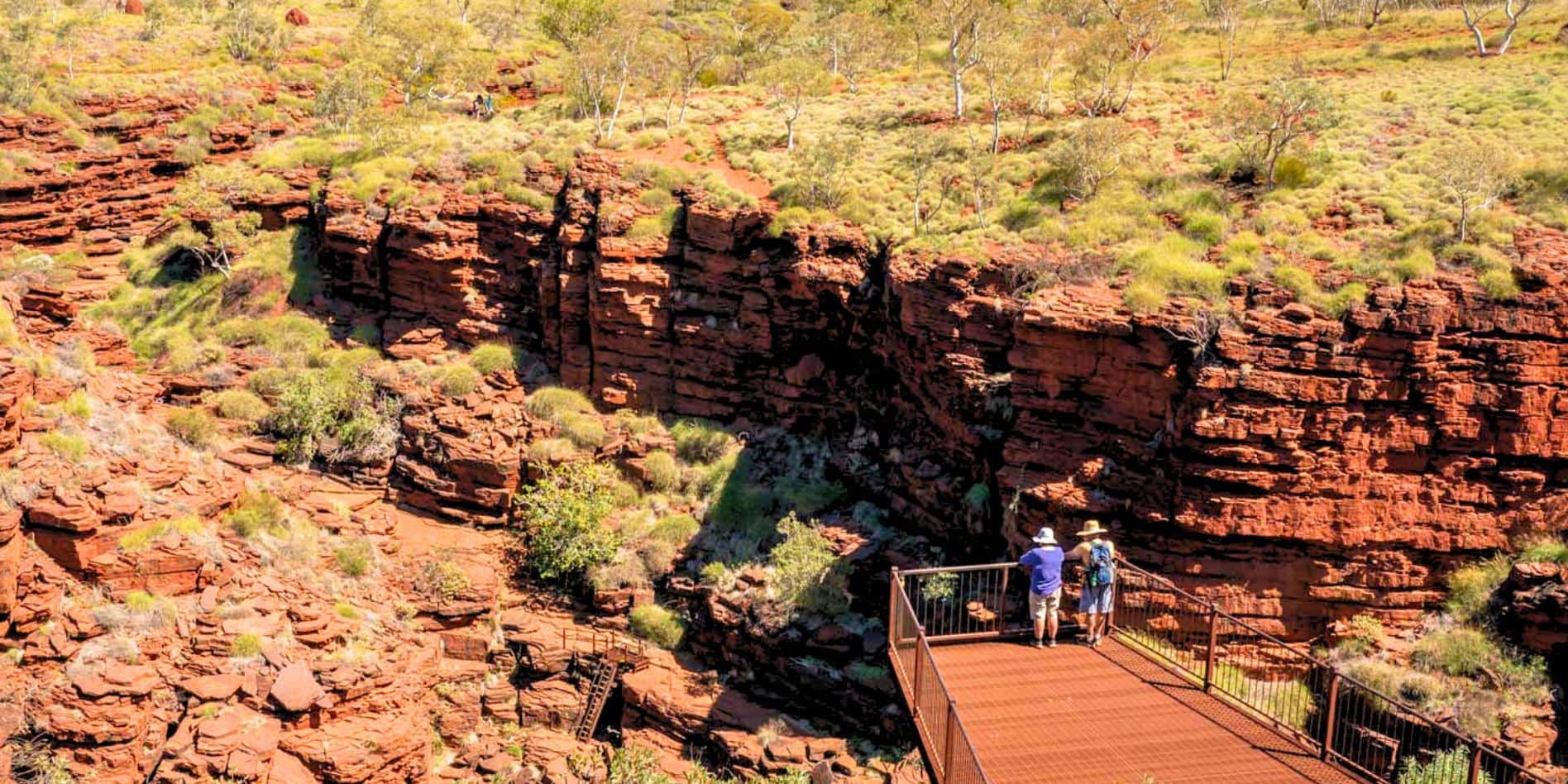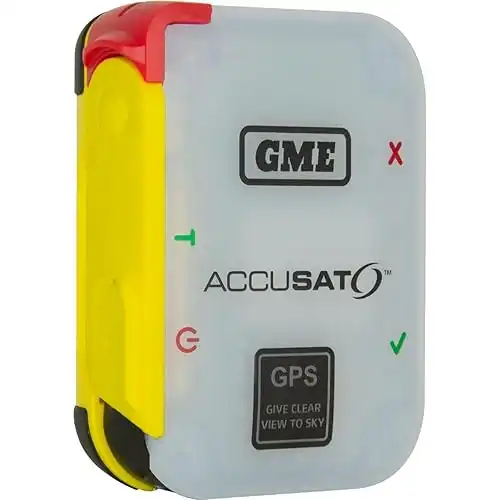Camping in Karijini National Park offers an unforgettable adventure. Imagine waking up to the sound of native birds and ending your day under a sky full of stars.
Over five days, we set up camp in Karijini, exploring its ancient gorges and soaking in its natural beauty. This immersive experience lets you fully embrace the rugged beauty of one of Australia’s most breathtaking national parks.
If you’re planning a trip to Karijini and want to know more about Karijini tips and a complete itinerary, check out our Guide to Karijini National Park for everything you need to plan your adventure.
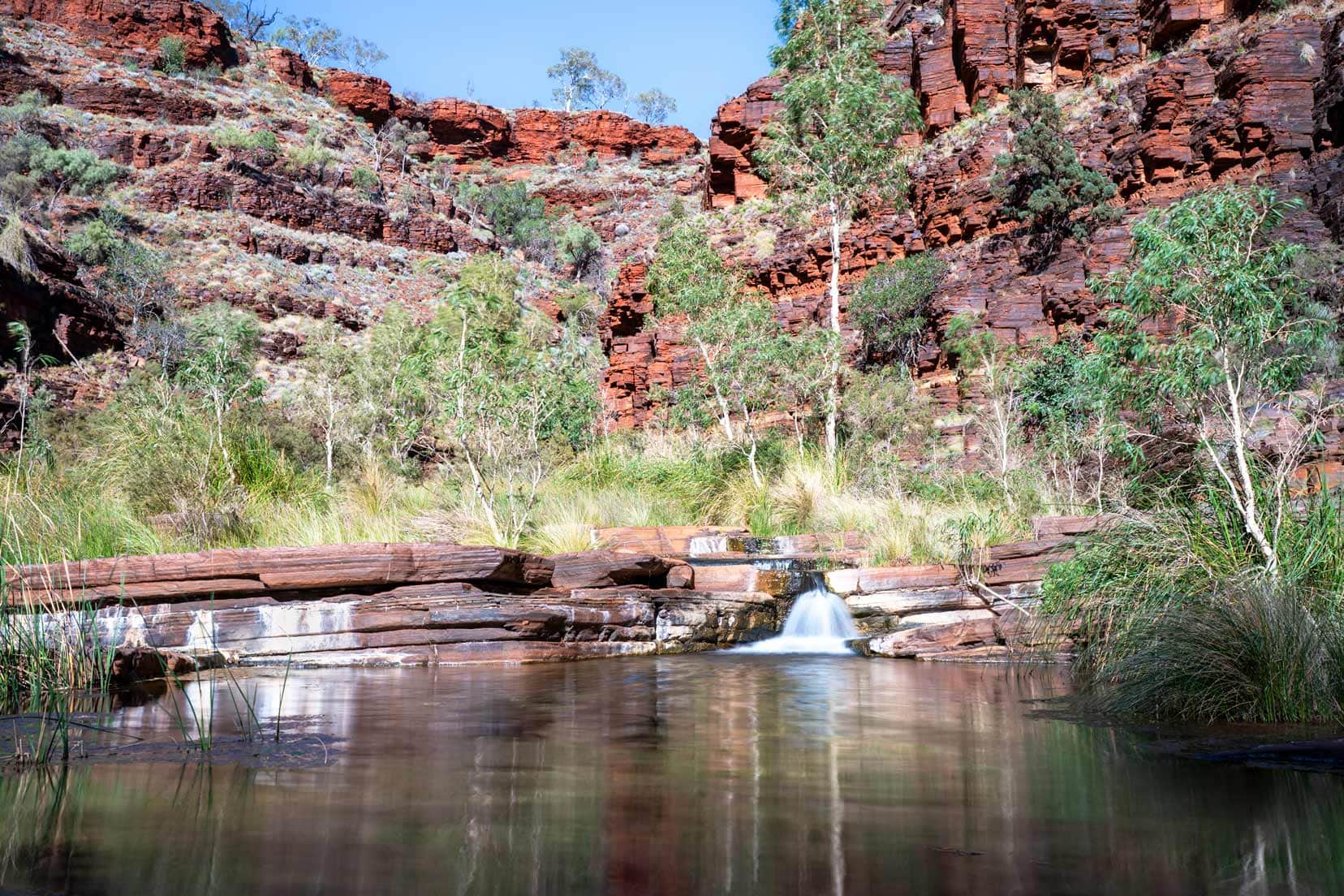
Camping in Karijini National Park: In a Nutshell
Campsites in Karijini
- Dales Campground: Budget-friendly, no-frills camping near Dales Gorge, ideal for those seeking a peaceful, natural setting.
- Drop toilets only
- There is no water or showers. (Showers are available for $4 at the Karijini Visitor Centre, 12 km away.)
- Karijini Eco Retreat: This option is more comfortable, with flush toilets, hot showers, mobile network connection (Telstra and Optus), and a restaurant. It is perfect for those wanting a balance between wilderness and amenities.
Campsite Options Outside Karijini
- Free Camps: For off-grid enthusiasts, Buddha’s Camp (near Hamersley Gorge) and another free camp (noted on Wikicamps) just outside Karijini provide seclusion but no facilities.
- Tom Price Caravan Park: This park offers a range of facilities and is about an hour’s drive west of Karijini.
- Auski Tourist Village: Powered and unpowered sites on a first-come, first-served basis. About 56km northeast of Karijini.
Karijini Wildlife
- Dingoes, flying foxes, and abundant birdlife like spinifex pigeons are common sightings. Kangaroos, Wallabies, and the endangered northern quoll are also present but more elusive.
Best Time to Visit Karijini
- April to September: Cooler weather, making it ideal for hiking and exploring the gorges. Summer months (November to March) are extremely hot, with daytime temps exceeding 40°C.
Top Gorges to Explore
- Highlights include Hammersley, Hancock, Joffre, Dales and Kalamina Gorge, our personal favourite.
Must-Pack Essentials
- Bring plenty of water, food, insect repellent, sunscreen, a hat and your camera! Be prepared for remote conditions and limited facilities.
Grab our Free Camping Checklist for your Trip here and check out our top tips for camping in WA here
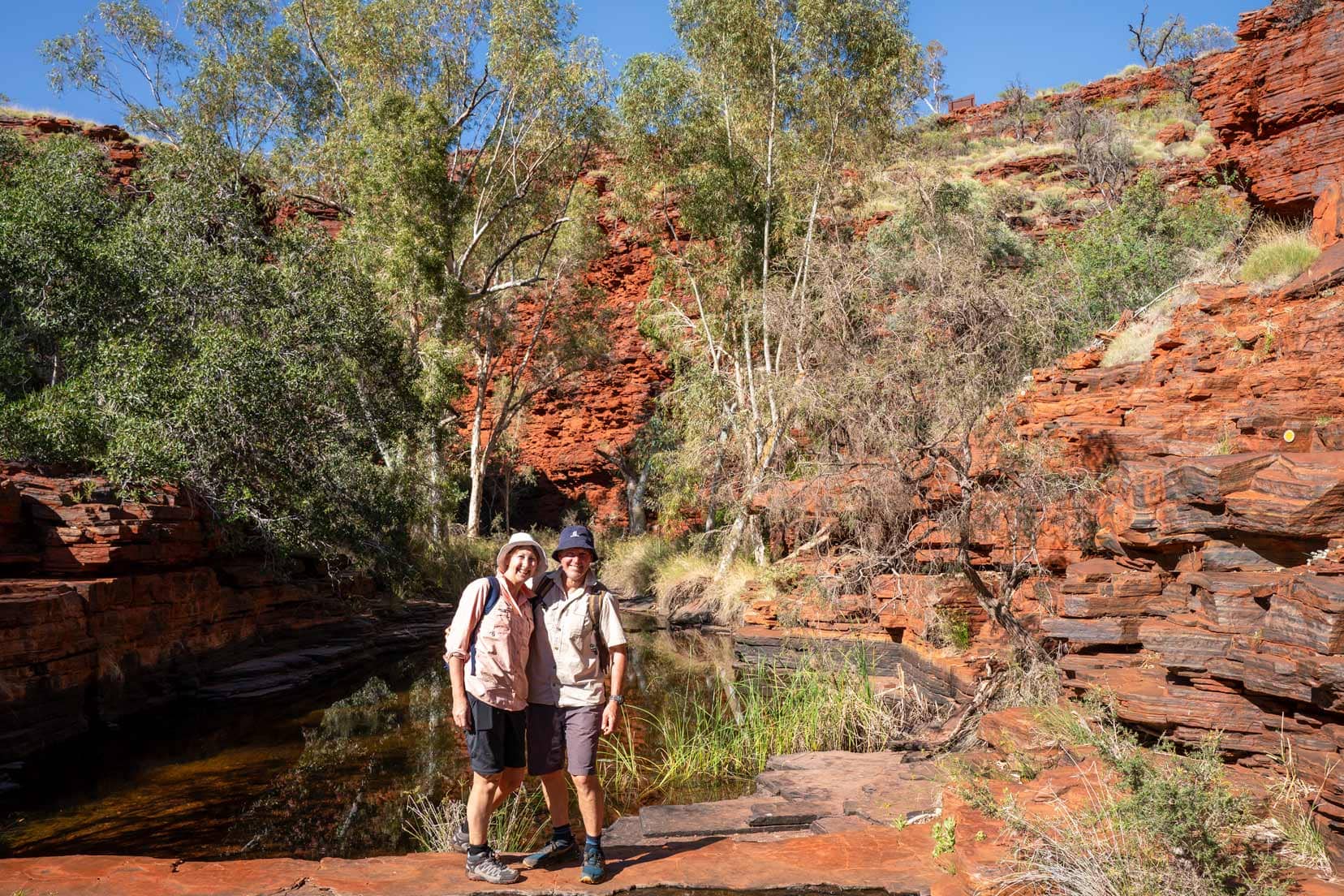
Why Camp in Karijini?
Camping in Karijini National Park lets you start your hikes early, avoiding the heat and crowds while witnessing the park’s spectacular gorges at dawn.
Plus, the sunrise and sunset over the dramatic Pilbara landscape are moments you won’t want to miss!
There are several gorges to explore in Karijini:
- Hammersley Gorge
- Joffre Gorge
- Knox Gorge
- Weano Gorge
- Hancocks Gorge
- Kalamina Gorge – See our complete guide and why Kalamina was our favourite gorge here.
- Dales Gorge
👉 For a detailed guide and suggested itinerary, check out our Karijini Itinerary and Ultimate Guide.
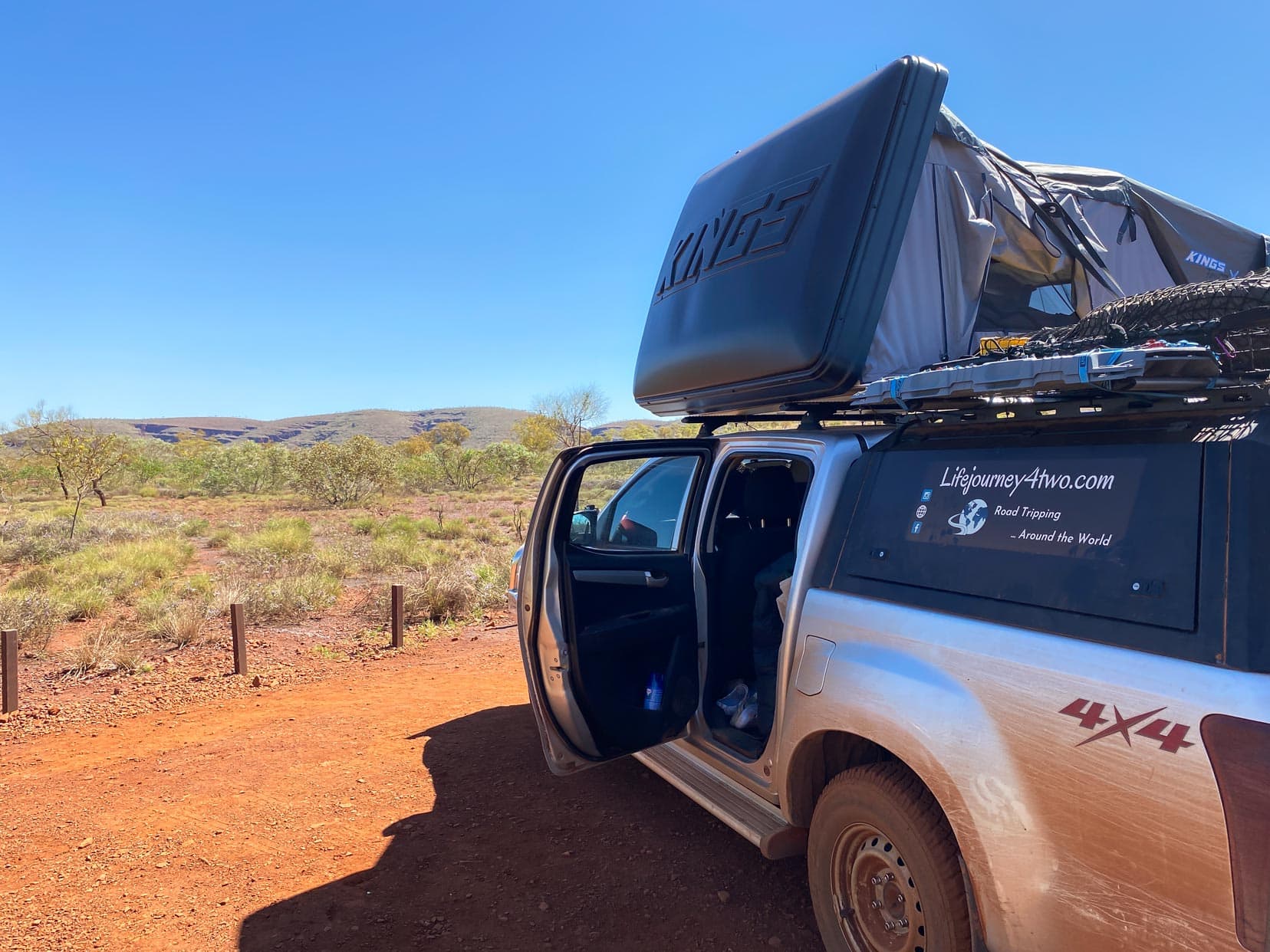
Karijini Camping Map
Camping Options inside Karijini National Park
There are two campgrounds inside Karijini National Park: the more basic government-owned Dales Campground and the privately owned Karijini Eco-Retreat.
Just outside the park are a couple of free options, but neither has any facilities. The next nearest campsites are Tom Price Caravan Park to the southwest of Karijini and Auski Tourist Village to the northeast.
Here’s a quick overview of the Karijini campsites with more detail on each below the table:
| Campground | Facilities | Access to Gorges | Best for |
|---|---|---|---|
| Dales Campground | Drop toilets | Dales Gorge, Fortescue Falls and Fern Pool | Budget campers seeking a basic, quiet experience |
| Karijini Eco Retreat | Flush toilets, showers, restaurant/bar | Joffre Gorge | Non-powered sites and Glamping tents available – access to extra amenities |
| Buddha’s Camp | None (Free camp) | Hamersley Gorge | Off-grid, self-sufficient campers who love solitude |
| Free Camp (Wikicamps) | None (Free camp) | Various gorges within Karijini | Off-grid campers near the park boundary |
| Tom Price Caravan Park | Showers, laundry, powered/unpowered sites | About 70 km (1-hour drive) from Karijini | Those looking for more amenities while still near Karijini |
| Auski Tourist Village | Powered/unpowered sites, shop, basic showers | About 56 km northeast of Karijini | Convenient access from the east side of the park |
Dales Campground
Dales Campground is an excellent option if you’re looking for a basic, no-frills camping experience near Dales Gorge. The campsites are spread over several loops, offering plenty of space and privacy.
While there are no showers or drinking water, the camp provides drop toilets, and you can set up your tent or caravan in a peaceful setting. Showers are available 12 km away at the Karijini Visitor Centre for a $4 fee. Note that the visitor centre is closed from December to February.
There are 153 non-powered sites, with only some areas allowing generators.
We stayed at Walru Loop, one of the furthest loops from the entrance. It was about a 30-minute walk to Fern Pool, one of the best swimming spots in Karijini.
The camp’s peacefulness and easy access to Dales Gorge made it an ideal spot for us to relax after long days of hiking. Note that there isn’t any Telstra signal here – but we were told Optus works.
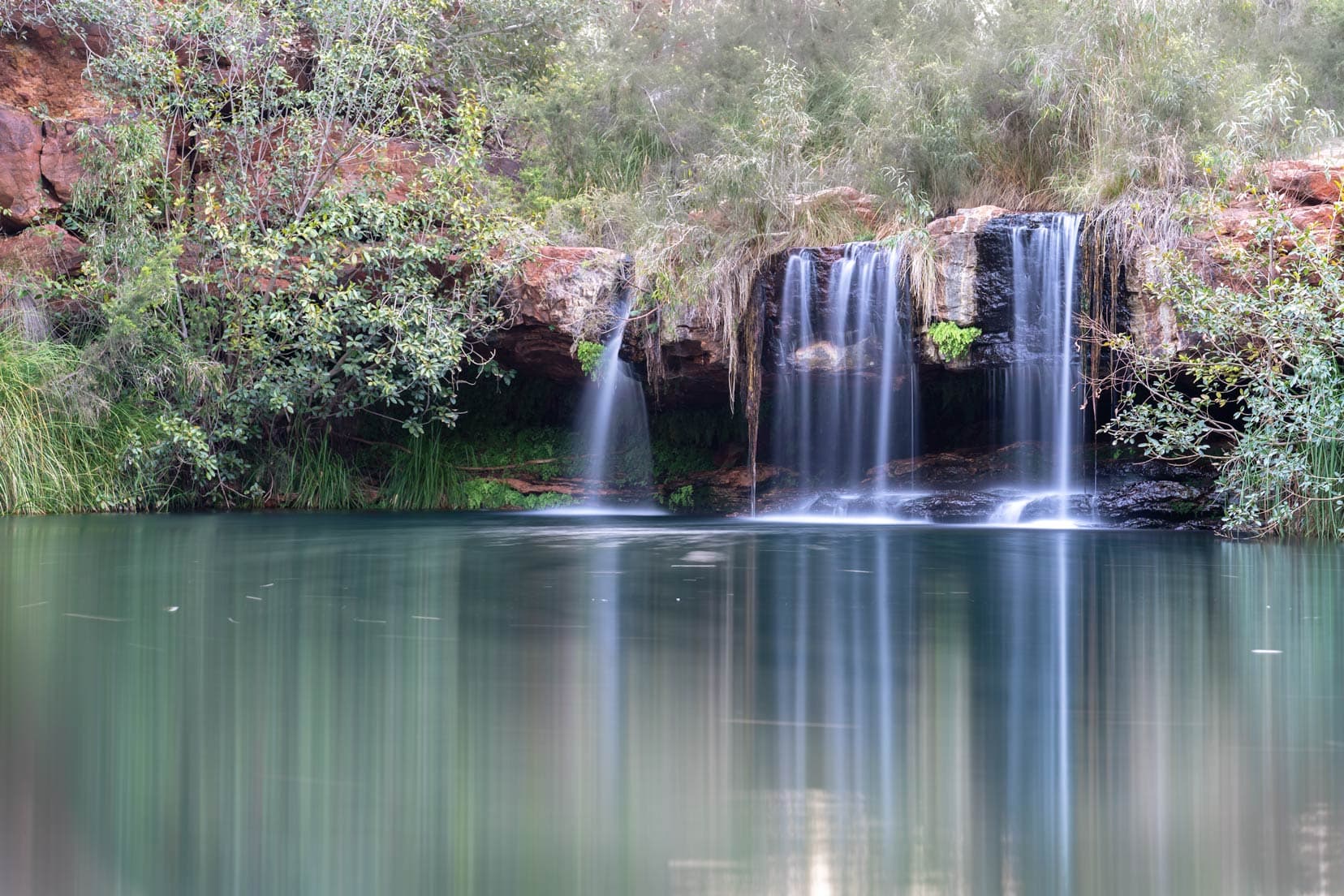
Pro Tip: If possible, try to book a spot further from the toilets—the smell can be a bit off-putting, depending on the wind direction!
You must book these campsites, which you can do six months beforehand. Book online at DBCA.
Please note that dogs and pets are not allowed in the campsite. An overflow option at Dales caters to peak periods, but you can only book for a maximum of two nights there.
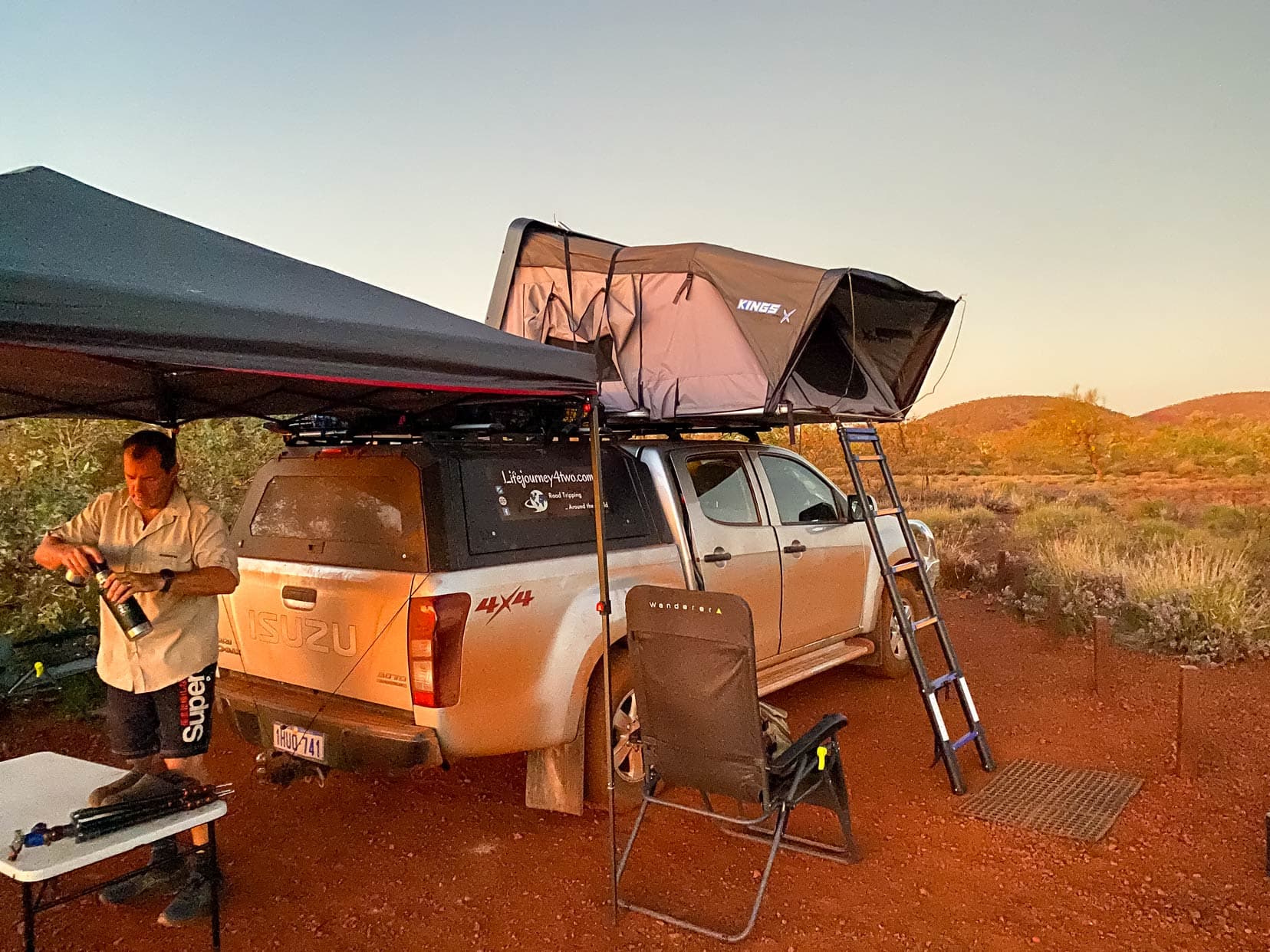
Getting to Dales Campground
- 83km from Auski Roadhouse/Tourist Village
- 108km from Tom Price
- 205km from Newman
Planning a road trip to Karijini National Park? Whether you’re navigating Australia’s vast outback or exploring remote gorges, it’s essential to plan ahead. Our detailed guide on how to plan a road trip offers tips on packing, route planning, and staying safe during long drives.
▶️ Click here for full details of our Perth to Karijini Road Trip
Karijini Eco Retreat
We stayed two nights at Karijini Eco Retreat on a non-powered site, enjoying a slightly more luxurious camping experience.
Located close to Joffre Gorge, this retreat offers a comfortable balance between nature and convenience. Flush toilets, hot showers, and a restaurant/bar are perfect for relaxing after a full day of exploring the rugged landscape.
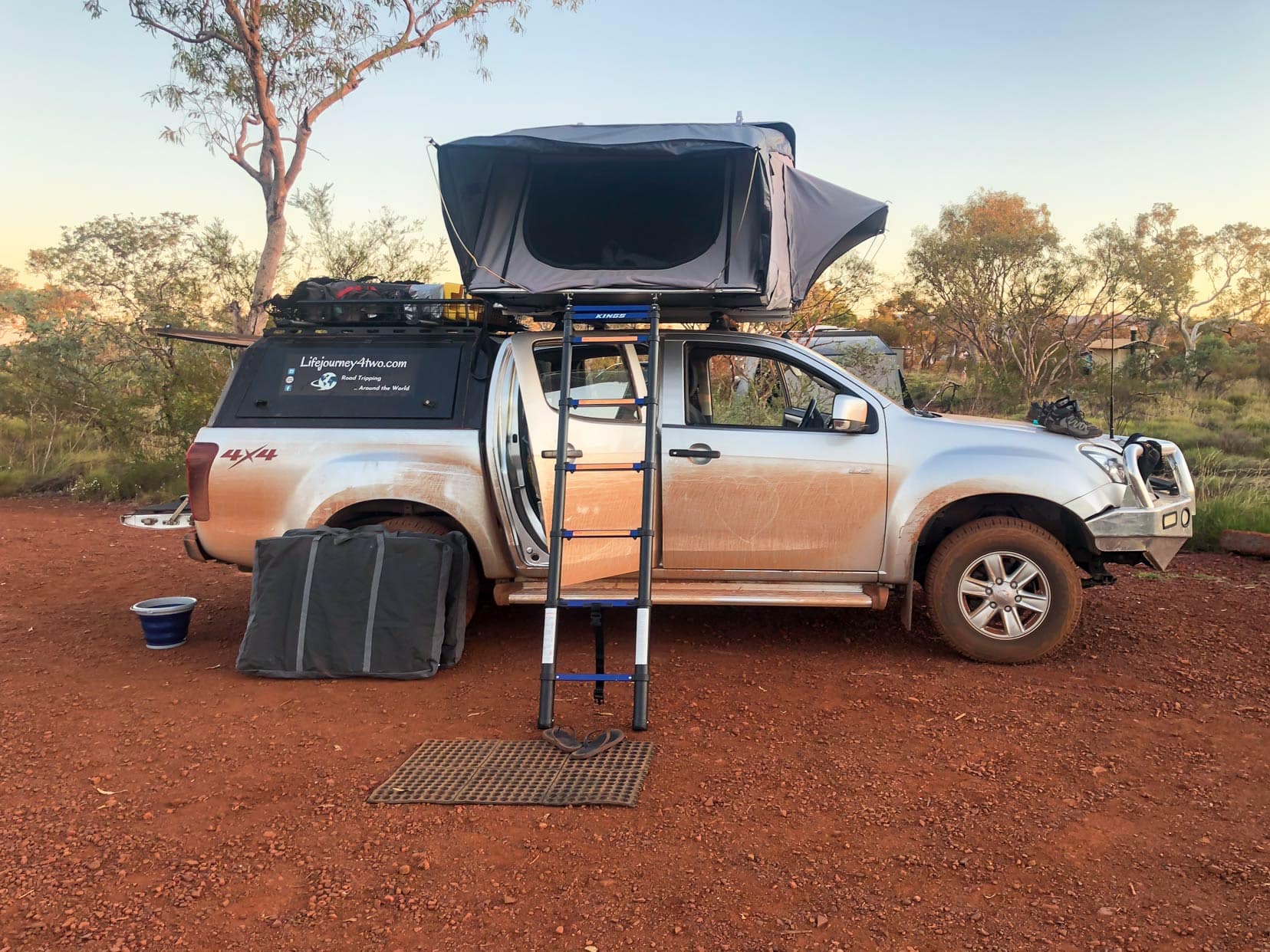
Even though we opted for the non-powered site, the retreat’s facilities made our stay much more comfortable, especially compared to the more basic camping at Dales Campground.
Staying here also meant easy access to Joffre Gorge, which is next to the retreat.
Pro Tip: The Eco Retreat is an excellent option if you want a comfortable camping experience while still being close to the action. Book your campsite online here, or if you prefer to glamp, book an eco-tent here.
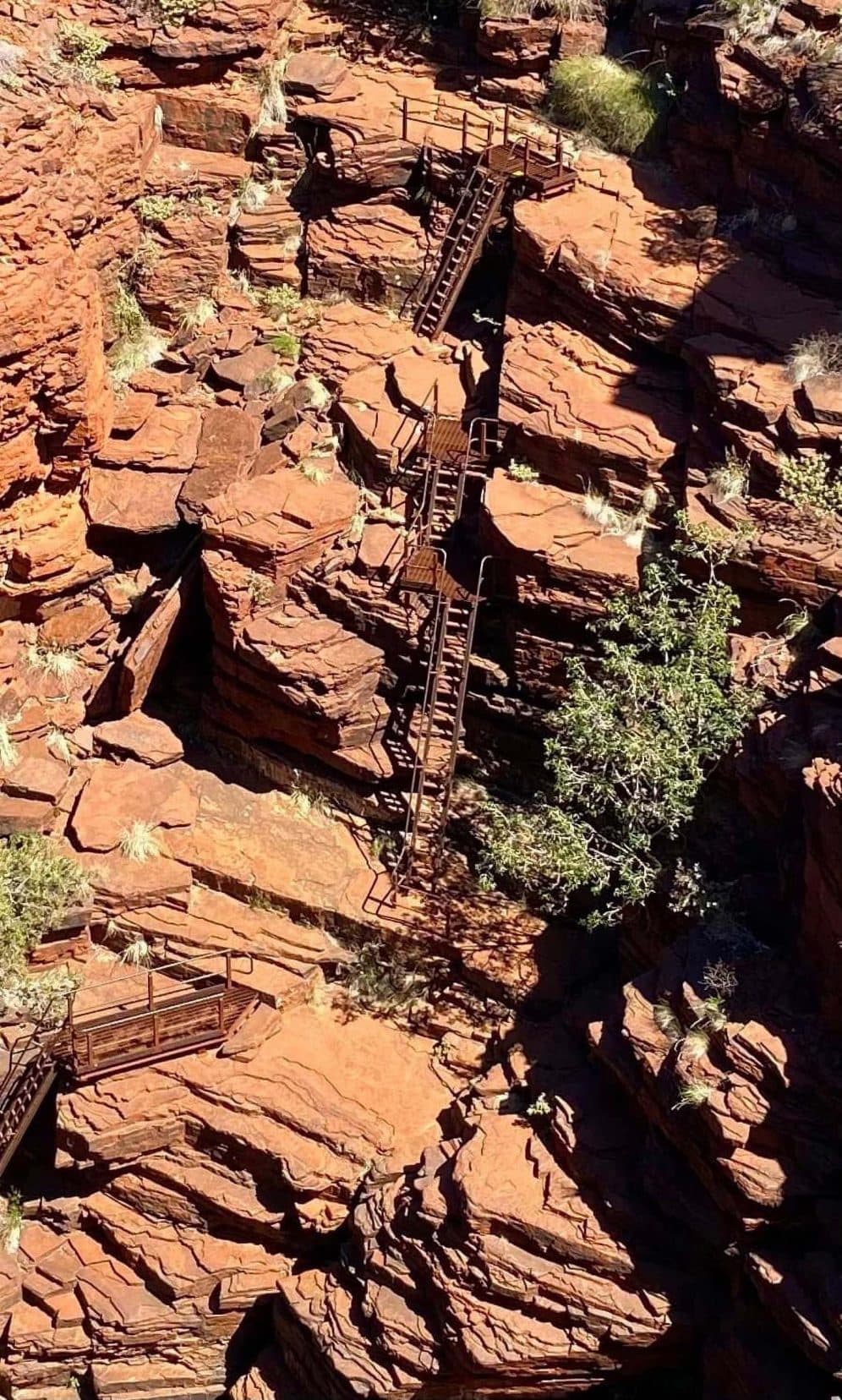
Buddha’s Camp
For a more off-the-beaten-path experience, head to Buddha’s Camp, a free camping area near Hamersley Gorge. This spot offers total solitude, but remember that there are no facilities. You’ll need to be entirely self-sufficient.
The camp is peaceful, offering plenty of spots off the main track for a quiet night under the stars. We stayed here for one night before heading to Hamersley Gorge and loved the seclusion. It’s a perfect spot if you’re happy with basic camping and prefer fewer people.

Free Camp (Wikicamps)
Another free camp, located just outside the park at 22°36’26.1″S 118°35’03.6″E, is a spacious spot similar to Buddha’s Camp.
WikiCamps reviewers say it offers plenty of room for campers but no facilities, so you’ll need to bring your own water and supplies. This is a good alternative for the more eastern side of the park.
Pro Tip: While both free camps offer great solitude, pack all necessary supplies as there are no amenities.
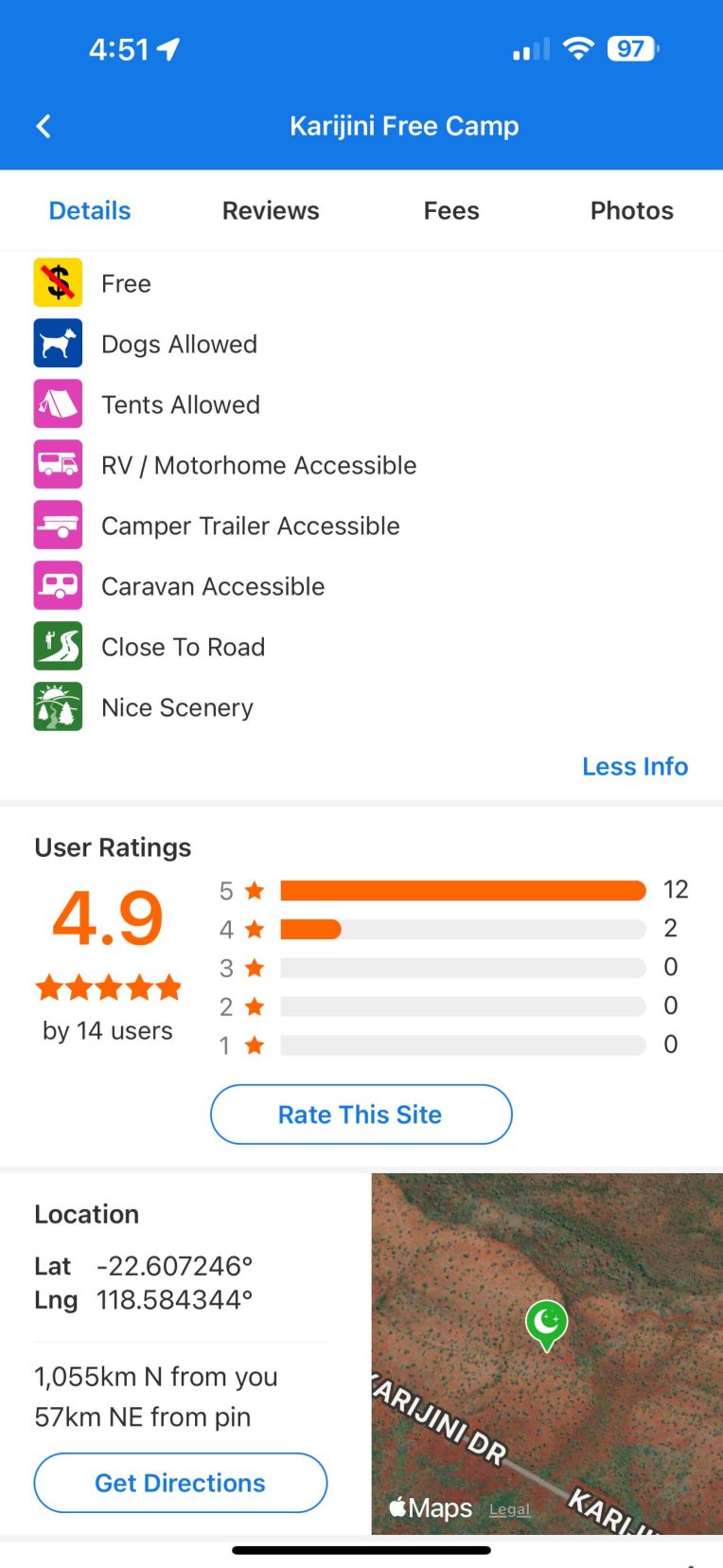
outside the park – a fluoro tie marks the turnoff on the road.
Tom Price Tourist Park
Tom Price Tourist Park is a great nearby alternative if you prefer camping with few more amenities.
Located around an hour’s drive from the park, this caravan park offers a range of accommodation options, including powered caravan sites, unpowered camping, and chalets.
It’s ideal for families or anyone seeking a bit more comfort after a day exploring Karijini’s rugged landscape.
We stayed here for a night before heading to Buddha Camp. We appreciated the extra amenities, like hot showers and on-site laundry facilities, especially after a few days of more basic camping.

It’s also a convenient base for refuelling and restocking supplies before heading into Karijini. We did a big shop at Coles and found the prices to be very similar to Perth and unlike the hiked prices in many of the smaller outback towns we passed on our road trip to Karijini.
The campsite sits under the nearby Mount Nameless, which offers fantastic views from the top. The extremely rugged 4WD track to the top is worth all the bumps and pits for the view.
Pro Tip: Book ahead, especially during peak season, as spots can fill up quickly, much like the campgrounds inside Karijini.
👉 For more details on Tom Price Caravan Park, check out their website.
Auski Tourist Village
We didn’t stay at this campsite, but powered and unpowered sites are available. The campsites cannot be booked beforehand, as they are on a first-come, first-served basis. There are bookable cabins, though.
As we left the park, we stopped at the roadhouse for fuel and bought a delicious breakfast wrap.
For our Karijini adventure, our trusty Isuzu Dmax camping setup made all the difference, allowing us to camp comfortably in remote areas. If you’re curious about how to create a versatile and reliable overlanding setup, check out our full guide on our Isuzu Dmax camping fitout.
🎁 Camping gear makes an excellent gift for outdoor enthusiasts. If you’re wondering what to buy for the camper or adventurer in your life, explore our top gifts for camper owners.
Park Fees and Camping in Karijini
The Karijini National Park entry fee is $17 per vehicle per day. If you plan to visit multiple national parks across Western Australia, consider purchasing a Holiday Pass or Annual Pass, which covers entry to all WA national parks. For more information, visit the official WA Parks Passes page.
When visiting Karijini National Park and camping at either Dales Campground or Karijini Eco Retreat, you only need to pay the park entry fee once for your stay.
However, if you leave and re-enter the park on different days without staying overnight, you must pay the entry fee each time.

Best Time to Camp in Karijini National Park
The best time to camp in Karijini National Park is between April and September. During these months, the temperature is cooler and more comfortable for hiking and exploring the park’s famous gorges.
Here’s a Seasonal Breakdown:
April to May
Following the wet season, April to May offers the fullest gorges and waterfalls. The days are warm but not too hot, making it perfect for both hiking and swimming.
June to August
These are the cooler months, with daytime temperatures averaging between 20°C to 25°C. Nights can get chilly, often dropping below 10°C, so pack warm clothing. This is the most popular time for visitors, so book campsites well in advance.
September to October
The temperatures begin to rise, but it’s still a great time to visit. Wildflowers bloom across the Pilbara, offering a unique experience for nature lovers. We camped in Karijini at the beginning of September, with temperatures in the high 20s and 30s.
November to March
These are the hottest months, with daytime temperatures exceeding 40°C, making it too extreme for most activities. Some gorges may be inaccessible due to flooding after heavy rains, and it’s not recommended to camp during this period.
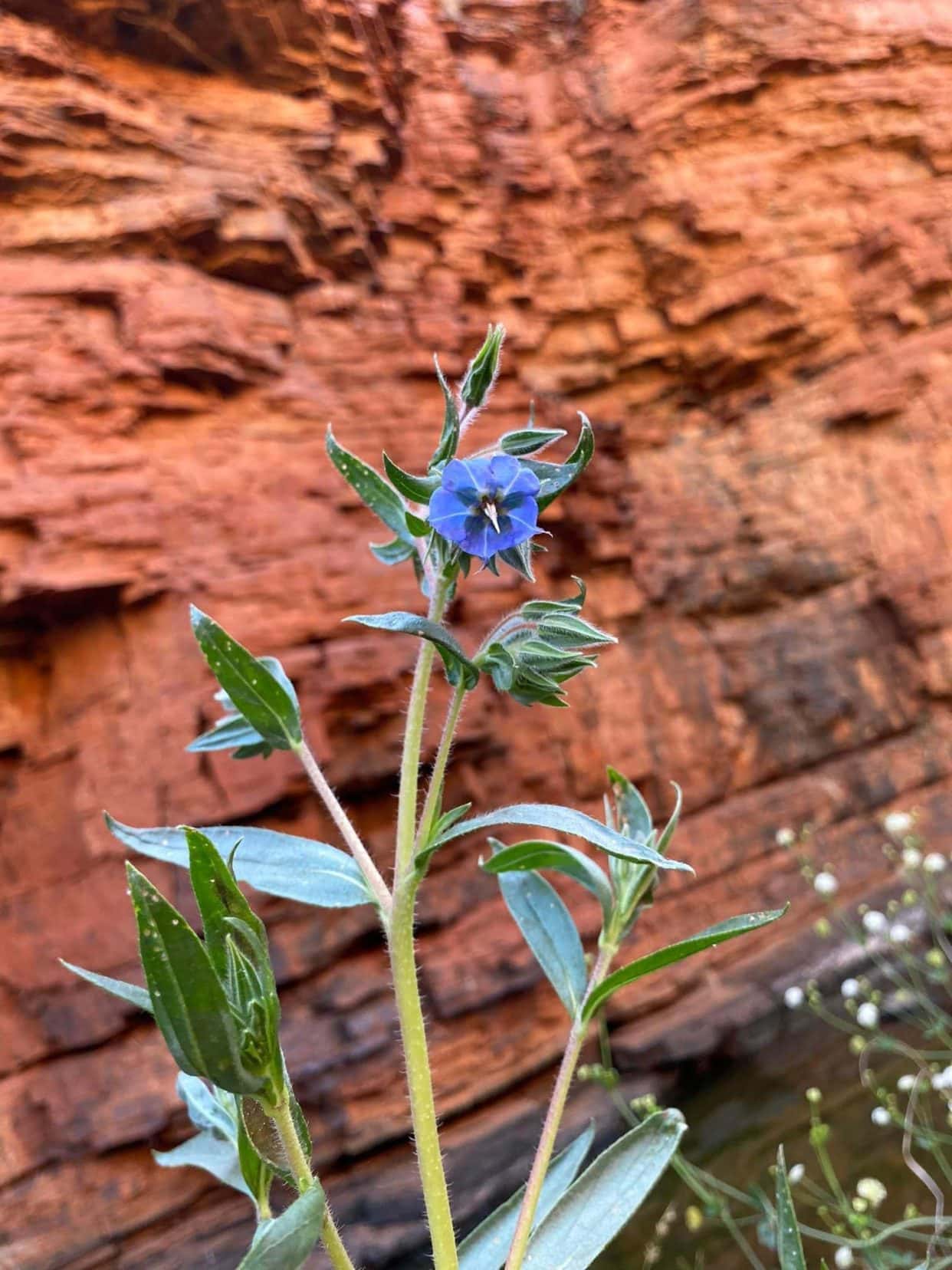
Essential Packing List for Camping in Karijini National Park
Here’s a list of must-have essentials for camping in Karijini, especially if you’re staying at more basic sites like Dales Campground or Buddha’s Camp:
- Water: There’s no drinking water at Dales Campground or Buddha’s Camp, so bring enough to last your entire stay.
- Food and Cooking Supplies: No food facilities are available at Dales or Buddha’s Camp. Stock up in Tom Price before entering the park.
- Insect Repellent and Fly Nets: Flies can be a nuisance, especially in the warmer months. A fly head net is essential to remain sane;)
- Water Shoes: These are crucial for hikes in Hancock Gorge or Joffre Gorge, where you’ll navigate slippery rocks and water crossings.
- First Aid Kit: Karijini is remote, and medical help isn’t easily accessible. Be sure to carry a basic first aid kit.
- PLB: We carry this with us on all our trips and keep it in our backpack for hikes. We have the GME PLB.
- Portable Shower: If you’re staying at Dales or Buddha’s Camp, a portable solar shower is useful since no shower facilities are available.
- Sunscreen and hat: The Pilbara sun is intense, so bring sunscreen and a hat to protect yourself.
- Headlamps/torches: You’ll need these if you want to go off exploring at night.
- Camera: Capturing the beauty of Karijini’s gorges, waterfalls, and wildlife requires the right gear. For those looking to document their adventure, we recommend checking out our travel photography gear guide, which covers the best cameras, lenses, and accessories for travel.
Long drives or quiet evenings at camp can be a great time to unwind with some fun travel games. If you’re looking for ideas to pass the time, check out our top travel games for two Players.
Wildlife in Karijini National Park
Karijini National Park is home to a diverse range of wildlife, some of which you might spot while camping. Although the rugged landscapes and deep gorges may seem remote, animals have adapted well to these harsh conditions. Here’s a glimpse of the wildlife you may encounter:
Dingoes
Both Dales Campground and Karijini Eco Retreat mention the presence of dingoes in the park. While these wild dogs may roam near campsites, it’s important not to approach or feed them.
Dingoes are naturally shy, but feeding them can alter their behaviour, making them more reliant on humans and potentially aggressive.
Although we didn’t see any dingoes, we saw paw prints around the perimeter of Dales Campground in the sand.
Wallabies and Kangaroos
Although we didn’t spot any wallabies or kangaroos directly in the gorges, we saw plenty of droppings, so they are around. Keep an eye out for these marsupials, particularly around dawn or dusk when they are most active.
🦘 We didn’t see any rock wallabies in Karijini but saw plenty of black-flanked wallabies at Pilgonoman Gorge in Cape Range in Exmouth.
Flying Foxes
A colony of Flying Foxes lives in the trees between Fortescue Falls and Fern Pool in Dales Gorge. You can often see them hanging from the branches during the day. Their presence and squabbling noises add a unique atmosphere to the walk between these two iconic swimming spots.
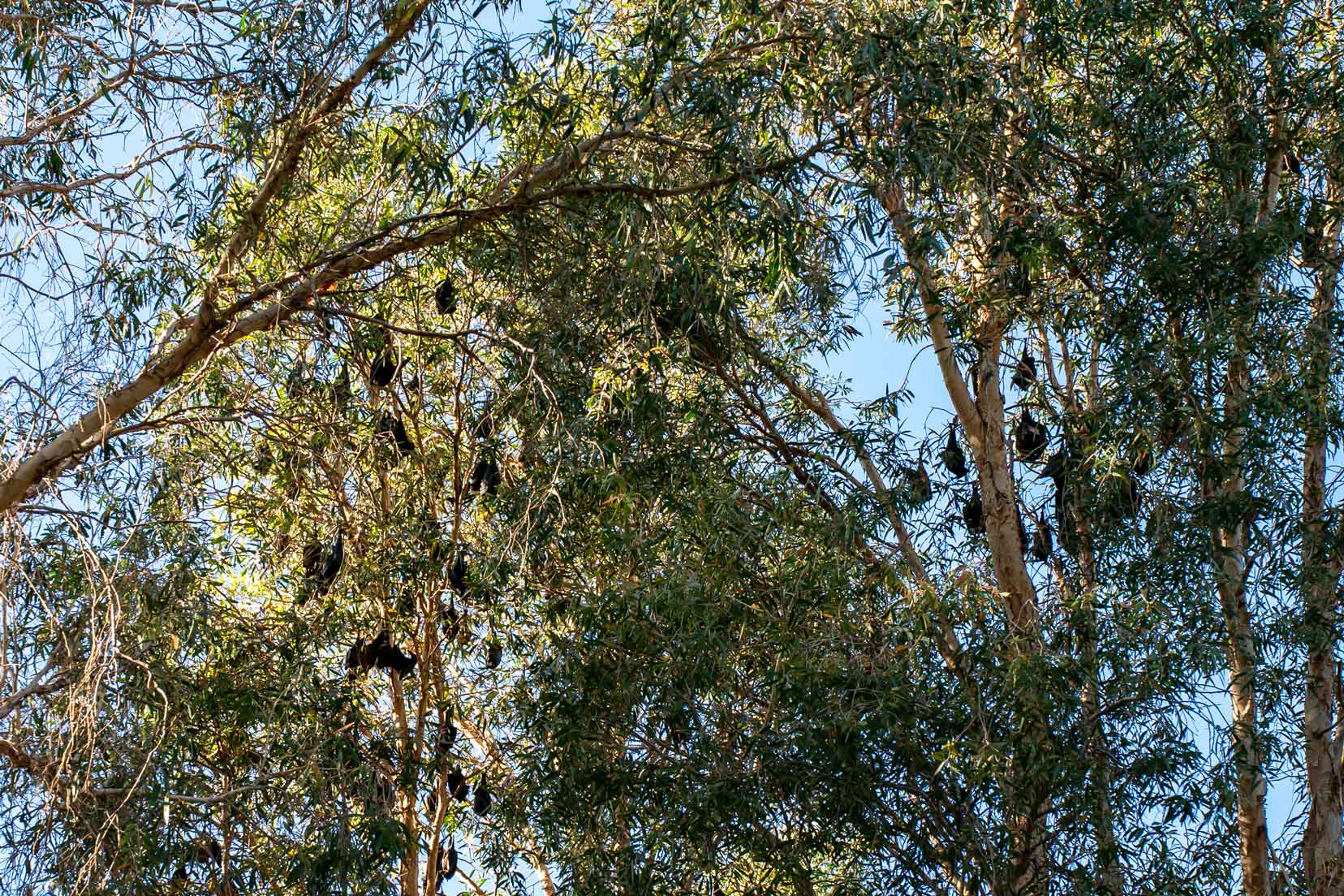
Northern Quolls
Signs indicate that Northern Quolls have been seen in the Dales Gorge area. These small carnivorous marsupials are endangered, so spotting one would be a rare and special sight.
Although we didn’t see one ourselves, we heard a large animal moving in the bushes and reeds while we were in the gorge. There were also plenty of burrow holes, so it’s possible a quoll was nearby.
Spinifex Pigeons
These small, ground-dwelling birds are pretty common in the park, and we frequently encountered them during our stay.
Their distinctive feathers and fan-like crests make them easy to identify, and they’re a delightful sight around the campsites.
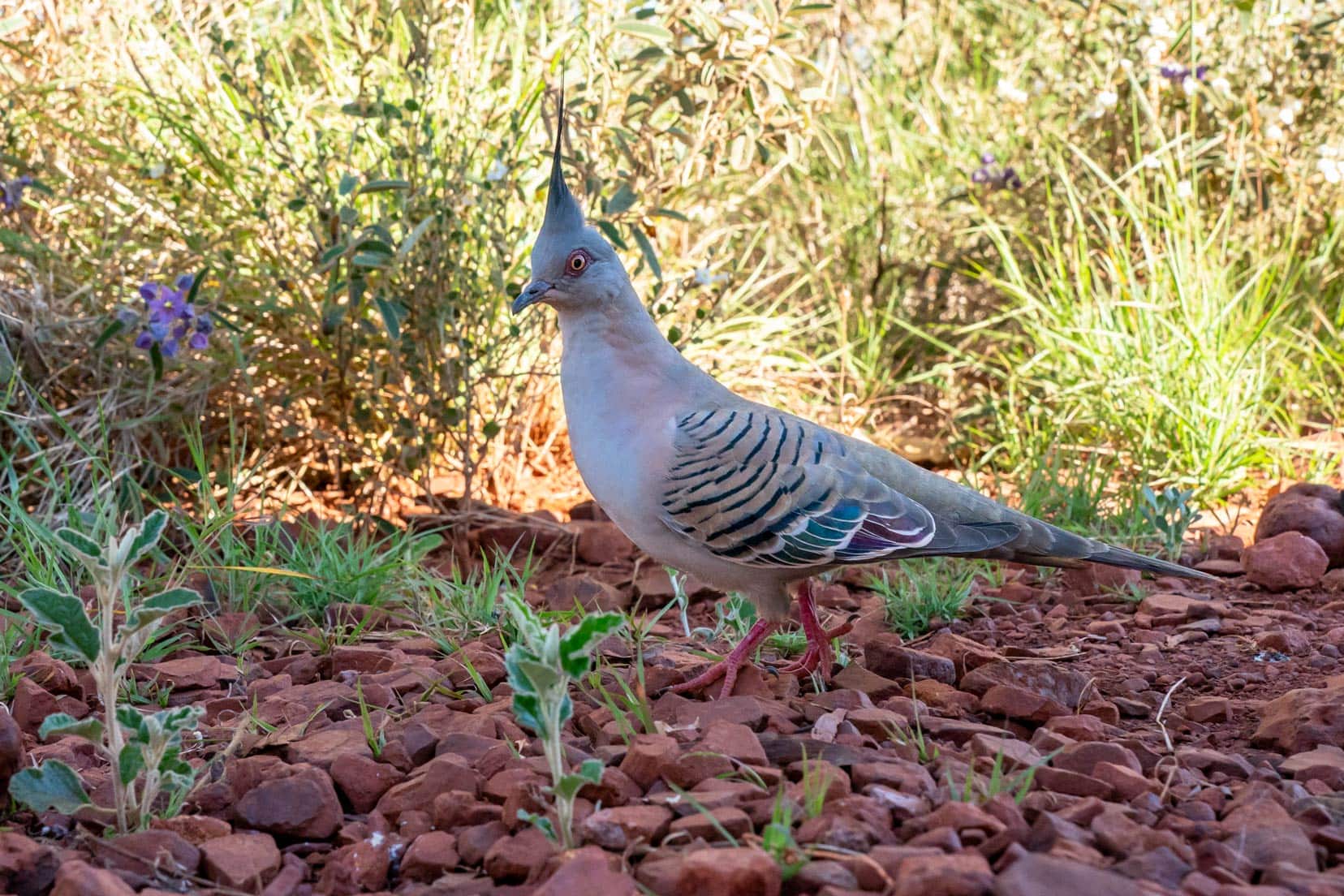
Birdlife
Karijini is rich in bird species, especially around waterholes. You’re likely to spot various birds, including honeyeaters, fairy-wrens, and finches. The gorges provide shelter and water, making them prime bird-watching locations.
Pro Tip: Keep your food secure and don’t leave scraps around, as this can attract unwanted attention from dingoes or other animals. Always follow wildlife safety guidelines to ensure a safe and respectful camping experience.
Karijini is home to some unique wildlife, from dingoes to northern quolls. If you’re interested in wildlife encounters beyond Karijini, check out our Animal Encounters post, where we share our favourite sightings from around the globe.
How to Make the Most of Your Camping Experience in Karijini
Start Early
Camping in Karijini National Park lets you start your hikes early before the heat and crowds arrive. The gorges, such as Hancock Gorge and Dales Gorge, are best explored in the cooler morning light, offering even more stunning views at sunrise.
Go-Off Grid
One of the unique experiences of camping in Karijini is the opportunity to disconnect. With limited phone reception—Telstra only works at the Karijini Eco Retreat and the Visitor Centre—you’ll have the perfect excuse to unplug and fully immerse yourself in nature.
Enjoy the Night Sky
The spectacular night sky is a highlight of camping in Karijini. With no light pollution, the stars are incredibly vivid, and you might even catch a glimpse of the Milky Way. After a day of hiking, lying under the stars was one of the most peaceful moments of our trip.
Visit the Visitor Centre
The Karijini Visitor Centre is more than just an educational stop—it’s your last opportunity to pick up ice cream (always a welcome treat for us), water shoes, or any extra supplies before you explore further. The centre also provides fascinating insights into the park’s geology and Indigenous history, making it a must-visit.
It is also worth stopping in here or at the Tom Price Visitor Centre to find out about any road or gorge closures. While we were there, the lower Weano Gorge section was closed due to an unusual infestation of millipedes.
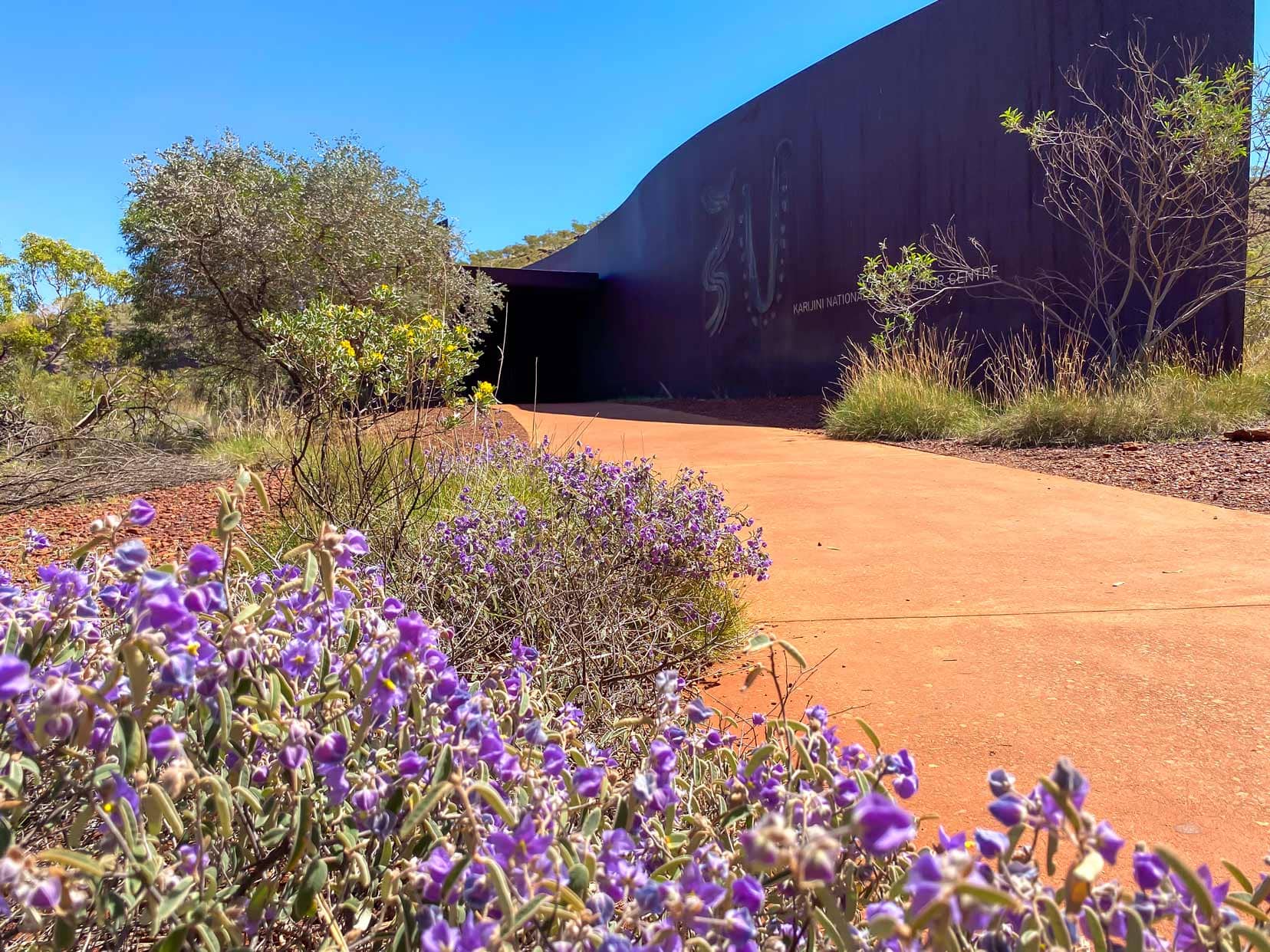
Is Camping at Karijini Right for You?
If you love adventure and being close to nature—and don’t mind roughing it a little—camping in Karijini National Park will be an unforgettable experience.
While the campsites are basic, the reward is unbeatable access to some of the most breathtaking landscapes in Australia.
For those seeking a balance between wilderness and comfort, Karijini Eco Retreat offers modern amenities like hot showers and a restaurant while still being immersed in nature.
If you prefer solitude and don’t mind skipping the luxuries, Buddha’s Camp provides a more remote and self-sufficient camping experience.

Karijini Camping FAQS
1. Can you camp for free in Karijini?
No, free camping isn’t allowed inside Karijini National Park, but there are a couple of free camps just outside the park boundaries. Buddha’s Camp and another camp listed on WikiCamps offer free camping options, though you must be self-sufficient.
2. What’s the best time to camp in Karijini?
The best time to camp in Karijini National Park is between April and September when the weather is cooler and more comfortable for hiking and exploring the gorges.
3. Where Should I Stay When Visiting Karijini?
There are two main camping options: Dales Campground, with basic facilities like drop toilets, and Karijini Eco Retreat, which offers more amenities like flush toilets, hot showers, and glamping tents. For those wanting a more remote experience, Buddha’s Camp near Hamersley Gorge is a free camping option with no facilities.
11. Can You Take a Caravan to Karijini?
Yes, caravans can access the main parts of the park, but it can be challenging for some locations like Kalamina Gorge or Hamersley Gorge, where unsealed roads can be tough for caravans to navigate.
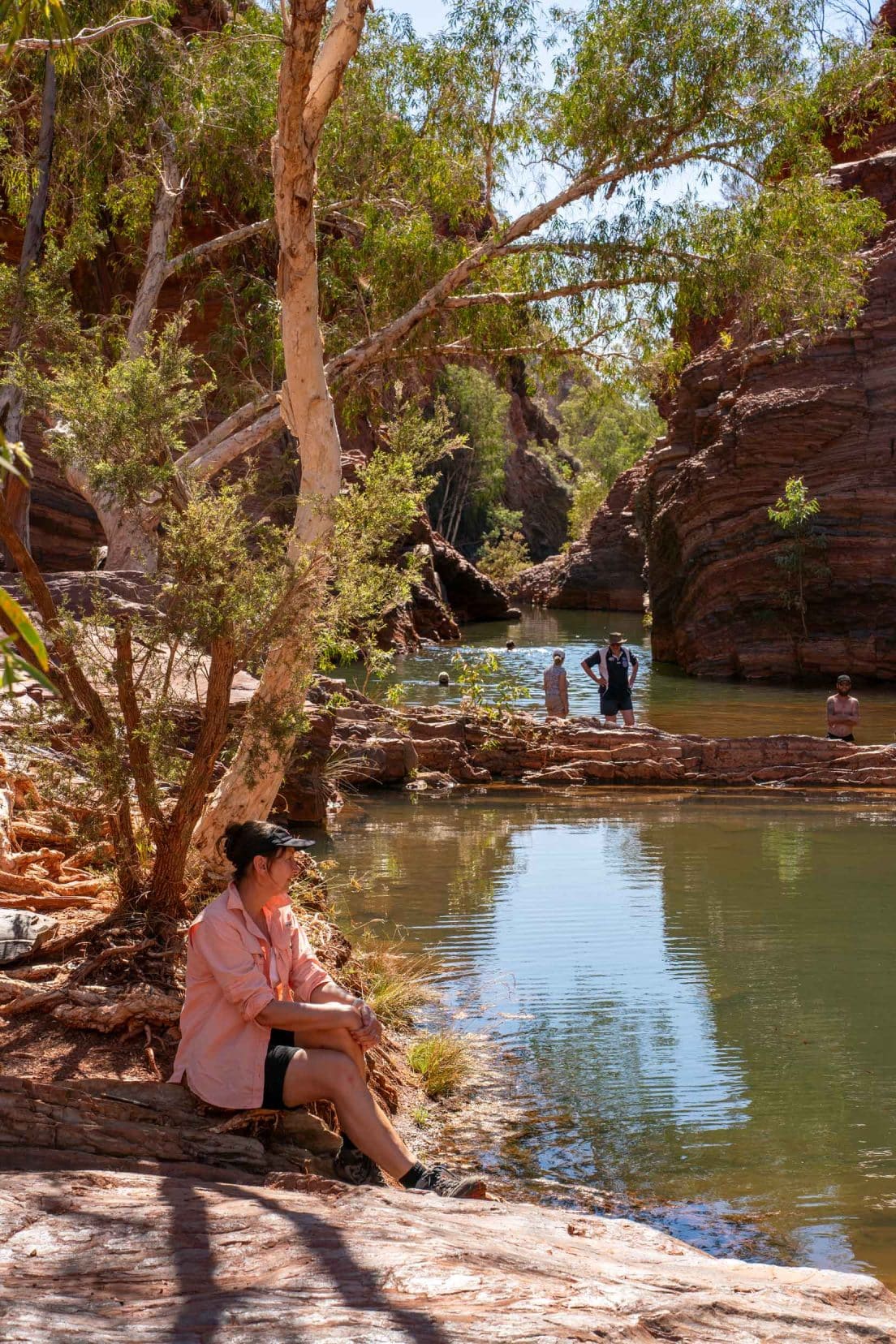
Camping in Karijini National Park … That’s a Wrap
Camping in Karijini National Park offers an immersive experience, from early morning hikes through stunning gorges to refreshing swims in hidden pools.
Whether you choose a more remote site or a comfortable retreat, being surrounded by nature under the vast Pilbara sky is an experience you’ll never forget.
So pack your gear, pitch your tent, and get ready to explore one of Australia’s most breathtaking national parks. If you’re planning more adventures in the region, check out our Perth to Karijini Guide and our Western Australia Page for even more incredible destinations.
Planning your trip to Karijini? Don’t forget to check out our Karijini Itinerary Guide.
Have you camped in Karijini? Share your experiences or ask any questions in the comments below—we’d love to hear from you!
Follow our journey on Facebook and Instagram for more photos, tips, and stories from our travels, including many off-the-beaten-path and breathtaking locations.
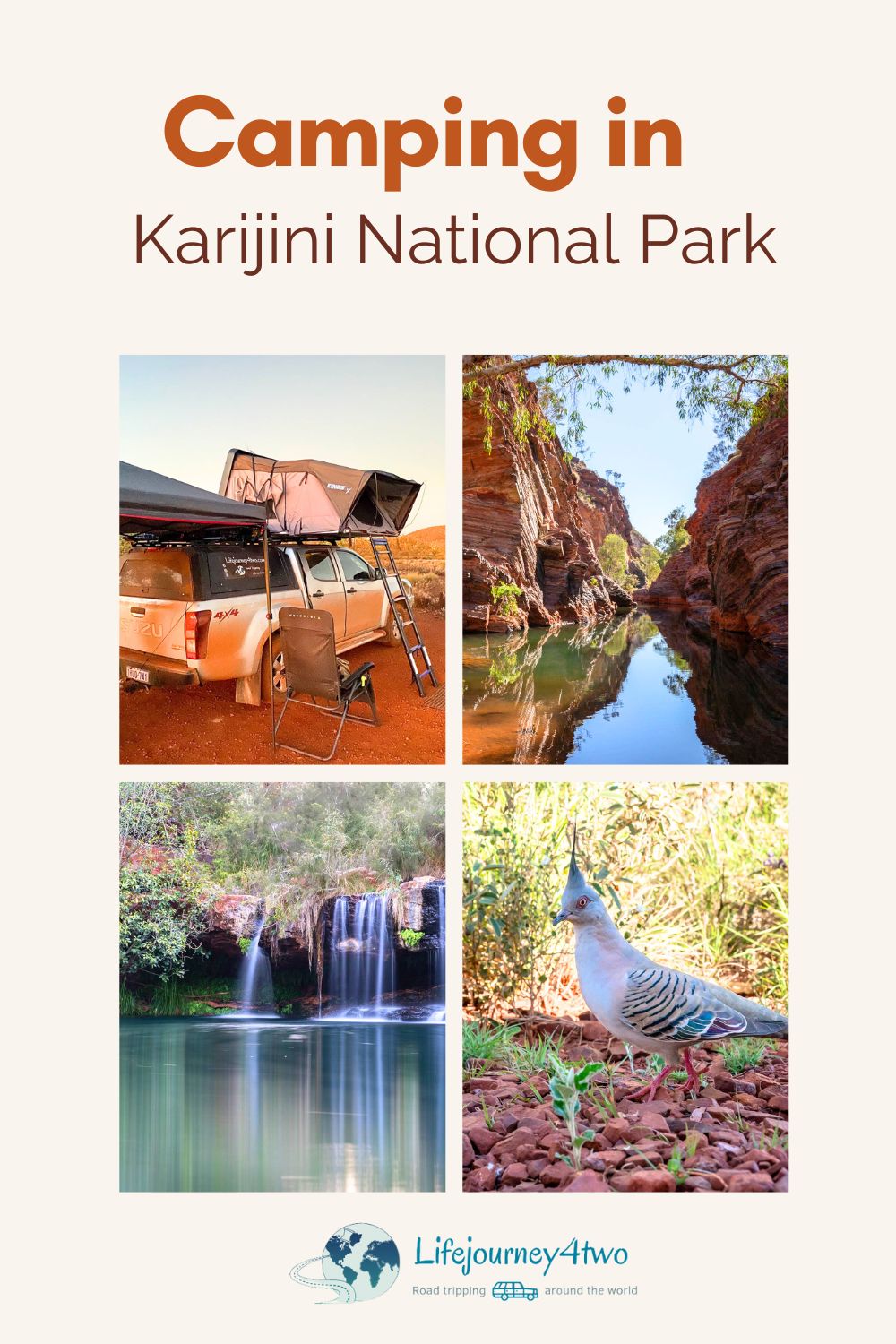
Planning Your Travels?
These are the travel resources we recommend and use when planning our trips.
- 🚘 Car Hire: We use DiscoverCars.com
- Motorhome/Campervan Rental: We highly recommend the Motorhome Republic
- 🪪 Order your International Driver’s Licence online here
- ✈️ Flights: Find flights on Skyscanner
- 🛏 Book Accommodation: We use Booking.com to find accommodation that suits our budget
- 🐶 Pet Sitting/Pet Sitters: Check Out TrustedHousesitters here (Use our Discount code: LIFEJOURNEY25 for 25% off. )
- Activities and Experiences: Get Your Guide and Viator
- Travel Insurance: Safetywing or World Nomads
- 🥾 Travel Gear and Accessories: Check out our top picks here — Lifejourney4two page on Amazon
For a more thorough list, visit our Travel Resources page here.

